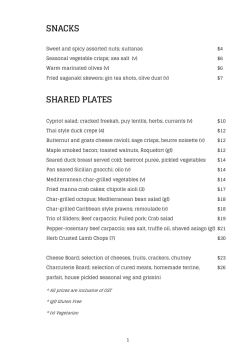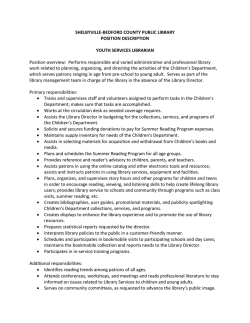
Selling catfish in local markets
fish processing area. A processing room has specific requirements, which are outlined in this manual: www.ksuaquaculture.org/Pubs.htm/ Catfish processing in Kentucky for Process & Market.pdf. A schematic diacommercial sales must be done in gram of a fish processing area can be HACCP-approved and Kentucky found in the following publication: Department of Public Healthhttp://www.ksuaquaculture.org/ inspected facilities. There are several Pubs.htm/AquaNews%20web%20Wsmall-scale fish processing facilities 07.pdf. in Kentucky where most of the work is done by hand, without any mecha- Since processing operations are costly, they add to the cost of the final product, nized help. e. g. fish fillets. The following publication list the costs of processing catfish at While building a processing facility $0.71 per pound (Small-Scale, On-Farm is usually expensive, farmers have found less-costly alternatives such as Fish Processing, Southern Regional Aquaculture Center Publication No. 442). converting an existing room into a Cost of processing fish at a small scale References 1. Catfish production manual: http://www.ksuaquaculture.org/PDFs/ Publications/Catfish.pdf 2. Catfish fingerling production manual: Durborow, R.M. Channel Catfish Fingerling Production In Kentucky. Kentucky State University, Kentucky Department of Agriculture, and National Oceanic and Atmospheric Administration, 2001. 3. Fish processing manual: www.ksuaquaculture.org/Pubs.htm/ Process & Market.pdf The Acquiring Farmland Fact Sheet is part of a series prepared by the Cooperative Extension Program at Kentucky State University. Dr. Terefi Tsegaye, Associate VP, Agricultural Administration and Land Grant Programs, and Dean This publication reported that the total fillet weight per fish (aka fillet dress-out) was 53% of the whole fish weight. If the cost of producing a food-sized catfish was $1.20 per pound, the cost of producing the fillets was ($1.20 ÷ 53%) + $0.71 = $2.97 per pound. Therefore, catfish fillets must be sold at prices higher than $2.97 per pound for producers and processors to realize a profit. 4. Economics fact sheet: Engle, C. R. and N Stone. Costs of Small-Scale Catfish Production for Direct Sales. https:// srac.tamu.edu/index.cfm/getFactSheet/ whichfactsheet/150/, 2014. 5. Low-density catfish farming publication: Wurts, W. A. Small-scale and Home Use Channel Catfish Farming in Kentucky. http://www2.ca.uky.edu/ wkrec/SmallScaleHomeUse.PDF. The Catfish Institute (uscatfish.com) has 5. Catfish production report: Hanson, T. many recipes that will assist beginning and D. Sites. 2014. 2013 U. S. catfish farmers in the local marketing of catfish. Database. www.agecon.msstate.edu/ whatwedo/budgets/docs/catfish/ toc_2013_1.pdf For more information, contact: Dr. Siddhartha Dasgupta, Professor Kentucky State University Aquaculture Research Center Frankfort, Kentucky 40601 Visit us on the WEB! www.kysu.edu/CAFSSS KYSU-000043 Educational programs of the Cooperative Extension Program serve all people regardless of race, color, national origin, sex, religion, age disability, political beliefs, marital or familial status. COOPERATIVE EXTENSION PROGRAM COLLEGE OF AGRICULTURE, FOOD SCIENCE, AND SUSTAINABLE SYSTEMS Selling catfish in local markets Dr. Sid Dasgupta and Mr. Richard Bryant Aquaculture and local foods The aquaculture industry in the United States is relatively small when compared to other animal husbandry industries such as beef cattle, hogs, or poultry. U. S. aquaculture is primarily noted for large-scale production of rainbow trout and catfish. Smaller volumes of other freshwater fish such as hybrid striped bass, tilapia, largemouth bass, yellow perch, and walleye are also produced. Crustaceans such as marine shrimp, freshwater prawns, crayfish are produced in the United States, but at even lesser volumes. Of various types of catfish available, channel catfish and hybrid catfish (the progeny of channel catfish females and blue catfish males) are typically cultured. The pond culture of catfish in Kentucky is relatively common and the Jackson Purchase Region of Kentucky has a small commercial catfish industry. Of the various types of aquaculture options available to Kentucky’s beginning farmers, catfish farming in ponds should be given serious consideration. This is because pond-based catfish production systems are very well-developed in the U. S. South. This means that scientists have worked out the details of how to stock, manage, and harvest ponds efficiently. There is much information and support related to production management, water quality requirements, disease management, and production economics for catfish. Catfish is also a marketing success in the United States. Catfish is a tasty and popular food item with 2012 U. S. per capita consumption of 0.5 pounds (Hanson and Sites 2014). Its popularity gives catfish sales potential in direct markets. This fact sheet investigates marketing results obtained from investigating consumer perceptions and willingness-to–pay (WTP) for locally-grown catfish in Kentucky’s mar- Basic catfish farming concepts Catfish fingerlings are available from suppliers in Mississippi and Arkansas. Fingerlings are usually bought at sizes varying from 4 inches to 10 inches. A 4-inch catfish stocked in a pond might take over a year to reach 1.5-2.0 pounds, which is referred to as “food size” in the industry. Research in Kentucky has shown that fingerlings that are 9 inches or larger can reach food size in one year if stocked in Spring. Catfish can be grown at a low density without artificial aeration of ponds. More commonly, the fish are grown at stocking densities of 5,000 to 6,000 fish/ water acre in ponds that are aerated. Kentucky State University Experiment Station Number: KYSU-000043 Catfish specialists near you Beginning farmers would benefit from consulting with catfish specialists before starting production. Kentucky State University catfish specialists include Mr. F. Wynne (production ), Dr. W. Wurts (production), Dr. R. Durborow (production, disease and water quality), and Dr. S. Dasgupta (economics and marketing); their contact information are at www.ksuaquaculture.org. The Southern Regional Aquaculture Center, an USDA-funded organization, has a website with many fact sheets about catfish production at: https://srac.tamu.edu/ index.cfm/CategoryDetails/ whichcategory/3/ Mississippi, Arkansas, Kentucky & Alabama have Land Grant institutions with specialists who will assist beginning farmers This factsheet was partially funded by the United States Department of Agriculture, National Institute of Food and Agriculture, Beginning Farmers’ and Ranchers’ Development Program. Grant Number 2012-49400-19680 The data showed that the farmers’ markets patrons were familiar with To address these issues, a Kentucky catfish fillets: more than half of the farmers’ market survey was conduct- respondents cooked fish at home eied in 2012 that obtained information ther weekly or twice monthly, 39 perabout the perceptions of patrons tocent cooked catfish at home, and anwards fresh, locally-produced catfish other 24 percent ate catfish in restaufillets. The survey elicited data from rants. The flavor of locally-grown 71 customers, who had the opporcatfish was well received: a total of 59 percent of respondents said that they liked the catfish. Characteristics of farmers’ market patrons Total number of respondents = 71 68% of respondents were female 92% of respondents were Caucasian 78% of respondents had either a 4year college degree, graduate degree, or professional degree 69% of respondents shopped at farmers’ markets every week and an additional 27% shopped at farmers’ markets “a few times per month” 58% of respondents were between 30 and 50 years old The average household size was 2.62; the most commonly-reported household size was 2 The survey also obtained information about how much farmers’ market patrons were willing to pay (WTP) for catfish fillets. Most respondents were willing to pay between $6 and $8 per pound; the average willingness to pay was $7.14 per pound. Therefore, farmers’ market patrons were willing to pay a modest premium over the retail price of fillets. Perceptions of catfish fillets by CSA patrons CSAs (community-supported agriculture) are an increasingly common form of local food marketing where individuals can prepay for a supply of fresh produce during a growing season by a producer or a group of producers. Four Kentucky-based CSAs participated in this project and their patrons were provided with a pound of fresh locallygrown catfish fillets, with an easy-tofollow recipe, for their convenience. These patrons were asked to cook and taste the fillets and answer a questionnaire that was also given to them. Useful data were obtained from 80 patrons. The survey data showed that 93 percent of the respondents liked eating freshwater fish. Seventy-three percent of respondents wanted catfish fillets to be a regular item at their CSA. The average WTP was $6/pound, with 55 percent wanting to pay between $6$8 per pound. This showed that the average WTP was comparable to the retail price of catfish fillets. Only 15 percent of respondents did not want to buy catfish. 30% 24% 25% 20% 20% 15% 15% 10% 5% 3% 0% 1% 0% While most CSAs are known for fresh vegetables, many are diversifying into sales of animal protein such as eggs, poultry, beef, and sheep. Some CSA owners expressed a willingness to diversify into offering fish fillets to their 2 $4 $5 $6 $7 $8 $9 Distribution of willingness to pay (in $ per pound) for fresh, locally-grown, catfish fillets in Kentucky’s farmers’ markets. The sum of percentages is less than 100% because not all survey respondents answered the willingness to pay question. Anecdotal evidence from poultry and small ruminant farmers suggested that Hispanic consumers purchase live animals for home consumption. This inspired a project that investigated their willingness to buy whole (i. e., unprocessed) catfish on ice. Hispanic grocery stores in Lexington and Shelbyville, Kentucky, were recruited to feature the sale of unprocessed, locally-sourced catfish on ice. These two cities were selected due to their large Hispanic population proportion. At each store, Hispanic customers were engaged in a simple bidding process to elicit their willingness to pay for the fish. If they bid “high enough”, they were allowed to buy catfish. These bids were recorded and the customers were surveyed to investigate their perception of catfish. The survey of Hispanic consumer resulted in an useful sample size of 73. Of these respondents 42percent were female, 77 percent were less than 40 years old, 52 percent had agricultural or factory work as livelihood, 25 percent were from Mexico and 39 percent were from Peru. $7.00 2% $6.50 $6.00 $5.50 0% $5.00 0% 2% $4.50 The survey data revealed that Hispanic consumers cooked fish frequently at home. The survey revealed that 75 percent of respondents either cooked fish weekly or twice monthly. 9% 7% 2% $4.00 The Hispanic population in Kentucky has been expanding rapidly. In 2000 it was 59,939 (1.39% of Kentucky population); in 2013 the estimated Hispanic population was 145,044 (3.30% of Kentucky population) (U. S. Census Bureau). If Hispanic consumers are willing to buy food directly from farms, they could be an important direct marketing resource for Kentucky’s producers. 16% 11% $3.50 customers. This motivated a marketing study where we elicited CSA patrons’ perceptions of locally-grown catfish fillets. 14% $3.00 tunity to taste the fillets and then respond to questions asked by an interviewer. Perception of fresh, whole catfish among Hispanic consumers 36% $2.50 Farmers’ markets are an obvious outlet for locally-grown fish. However, there are questions about how well catfish will be accepted in Kentucky’s farmers’ markets. Selling whole catfish to Hispanic consumers in Kentucky 40% 35% 30% 25% 20% 15% 10% 5% 0% $2.00 Acceptance of catfish fillets by farmers’ market patrons Maximum price ($/lb) bid by consumers Distribution of the willingness to pay for whole catfish by Hispanic consumers in Kentucky. The survey indicated that 81 percent of respondents preferred whole catfish, 53 percent preferred fresh gutted catfish, and an additional 25 percent wanted live catfish. Only 22% of the respondents preferred fillets. Characteristics of CSA patrons Total number of respondents = 80 59% of respondents were female The catfish price bidding data provided measures of the value that Hispanic consumer placed on the whole fish. Most Hispanic consumers were willing to pay between $2 and $7 per pound. Their average WTP was $4.63 per pound. The most frequent price that they were willing to pay was $5 per pound. 96% of respondents were Caucasian 89% of respondents had either a 4year college degree, graduate degree, or professional degree 54% of respondents lived in a suburban area 67% of respondents were between 30 and 50 years old Catfish sales to Hispanic grocers in Kentucky The average household size was 2.78; the most commonly-reported household size was 2 The results of the Hispanic consumer survey encouraged several Hispanic grocers to feature fresh, unprocessed locally-grown catfish at their seafood counter. Kentucky State University supplied catfish to the grocers every Friday, in order to record their sales over time. two weeks. The remaining grocers continued to purchase fish at prices ranging from $.125 to $1.75 per pound. They wanted fish between 1.5 and 2.0 pounds. Average weekly demand per store varied from 30 pounds to 60 pounds. Grocers equipped with meat processing facilities (i. e., carneceria) were able to process the whole catfish and sell gutted fish. Two Hispanic grocers in Lexington, two in Shelbyville, and one in Louisville sold whole catfish. The Shelbyville grocers were unable to sell catfish for more than 3
© Copyright 2025






